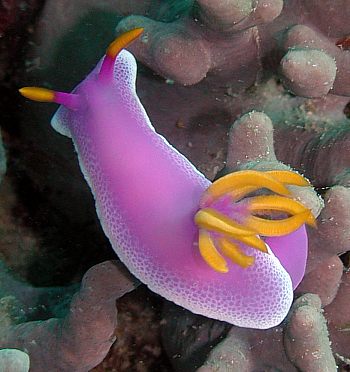
Hypselodoris apolegma
(Yonow, 2001)
Order: NUDIBRANCHIA
Suborder: DORIDINA
Superfamily: EUDORIDOIDEA
Family: Chromodorididae
DISTRIBUTION
Western Pacific
PHOTO
Tenggol Island off east Malaysia, 24 May 2002. Depth 13m. Photo: Kheong Sann Chan.
This 'species' has recently been described as Risbecia apolegma. On the Forum it has been considered closely related to Hypselodoris bullocki. Whether it is a colour form of that species or a distinct species is not clear to me. Have a look at the messages on the H. bullocki and H. apolegma pages to see some of the colour variation and discussion. Also look at Phil Slosberg's photo showing typical H. bullocki and H. apolegma mating.
Hypselodoris apolegma differs from H. bullocki mainly in colour. The background colour is a rich pinkish purple with a white border to the mantle. At the edge of the mantle the border is solid white but inside this is a region of varying width in which the white forms a reticulate pattern gradually merging in to the pinkish purple. The rhinophore stalks and the base of the gills is an intense purple, the rhinophore clubs and the gills are orange yellow. I can find no anatomical grounds to place this 'species' in the genus Risbecia.
Reference:
• Yonow, N. 2001. Part 11. Doridacea of the families Chromodorididae and Hexabranchidae (Mollusca, Gastropoda, Opisthobranchia, Nudibranchia), including additional Moluccan material. [In] Results of the Rumphius Biohistorical Expedition to Ambon (1990). Zoologische Meddelingen. Leiden, 75: 1-50.
Rudman, W.B., 2002 (October 29) Hypselodoris apolegma (Yonow, 2001). [In] Sea Slug Forum. Australian Museum, Sydney. Available from http://www.seaslugforum.net/find/hypsapol
Related messages
Re: Purple sea slug
March 3, 2009
From: Jason Sanders
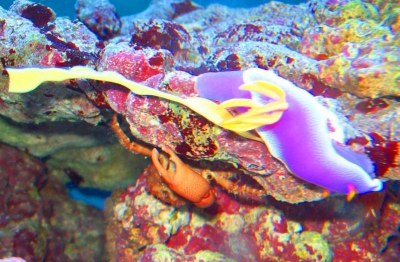
Concerning message #4316:
Just got my nudibranch and it looks like it has an egg ribbon
Jason Sanders
jasonbsanders@embarqmail.com
Sanders, J., 2009 (Mar 3) Re: Purple sea slug. [Message in] Sea Slug Forum. Australian Museum, Sydney. Available from http://www.seaslugforum.net/find/22198Dear Jason,
In the message you refer to [#4316 ] I suggest that keeping these animals in captivity is not a good idea. I also note that laying a mishapen egg ribbon, like yours is doing, is an indication that the animal is very stressed. Hypselodoris apolegma is a beautiful coloured animal, but it has no place in home aquaria where it can only slowly starve to death. Have a look at other messages about keeping nudibranchs in aquaria on the Keeping seaslugs in captivity Page. I realise you probably bought the slug with best intentions, but you should complain to the shop that supplied it. They shouldn't be stocking animals which are impossible to keep alive in home aquaria.
Best wishes,
Bill Rudman
Re: Hypselodoris bullocki - eggs
June 30, 2008
From: Jim Chambers
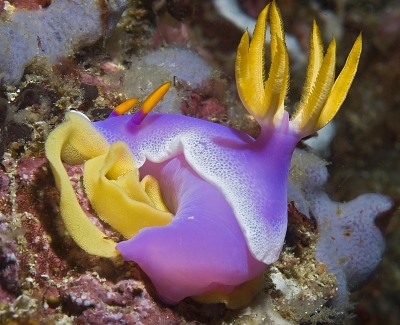
Concerning message #4063:
G'Day Bill,
I thought you might like to have another image of Hyselodoris bullocki laying eggs.
Locality: Anilao (Luzon), 45 feet, Philippines, Philippine Sea/Pacific Ocean, May 5, 2008, Coral reef. Length: 2.5-3.0 inches. Photographer: Jim Chambers.
Jim Chambers.
jimbo_limited@mindspring.com
Chambers, J., 2008 (Jun 30) Re: Hypselodoris bullocki - eggs. [Message in] Sea Slug Forum. Australian Museum, Sydney. Available from http://www.seaslugforum.net/find/21640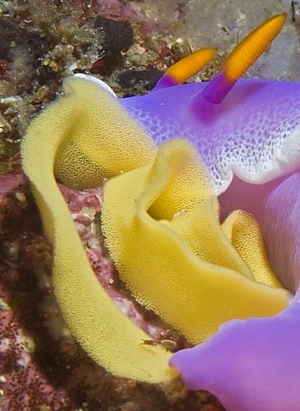
Dear Jim,
Thanks for the photo. It's good to get more than one observation of egg masses and food choice. As you will see from earlier messages, this colour 'form' has been named as a distinct species Hypselodoris apolegma, but as we now have photos of it mating with more typical H. bullocki and with a red-spotted form as well [message #20968], it certainly suggests we may need to widen the species concept for the H. bullockigroup.
Best wishes,
Bill Rudman
Re: Hypselodoris bullockii? & H. apolegma mating
June 4, 2008
From: Teresa Zuberbühler
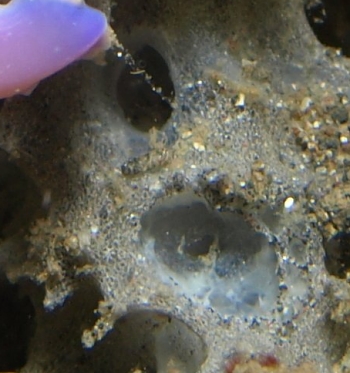
Concerning message #20968:
Here is a close-up of the sponge they were on.
Locality: Lembeh, Sulawesi, Indonesia, Pacific. Photographer: Teresa (Zubi) Zuberbühler.
Teresa Zuberbühler
webmaster@starfish.ch
Teresa (Zubi) Zuberbühler, 2008 (Jun 4) Re: Hypselodoris bullockii? & H. apolegma mating. [Message in] Sea Slug Forum. Australian Museum, Sydney. Available from http://www.seaslugforum.net/find/21599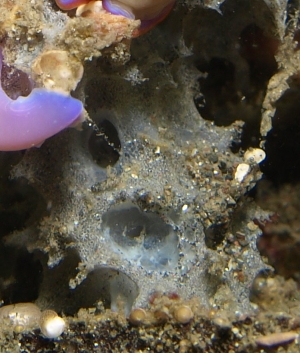
Dear Zubi,
Thanks for the photo. Yes it certainly seems to be on its usual sponge, which is a species of Euryspongia. One of them at least has eaten a large hole in the colony.
Best wishes,
Bill Rudman
Re: Hypselodoris bullockii? & H. apolegma mating
June 4, 2008
From: Reindert Grooters & Mieke Snoek
Concerning message #20968:
Hello Bill,
You were wondering about the 'red spotted' form of H. bullocki on the forum in your answer, and maybe you mean the species/photos that we have send in, message #19423. You have put it 'aside' as Hypselodoris sp.11. They look very much the same.
Regards,
Reindert and Mieke
mieke.reindert@chello.nl
Grooters, R. & Snoek, A., 2008 (Jun 4) Re: Hypselodoris bullockii? & H. apolegma mating. [Message in] Sea Slug Forum. Australian Museum, Sydney. Available from http://www.seaslugforum.net/find/21591Dear Reindert & Mieke,
It's not the photo I had in mind but Hypselodoris sp. 11 certainly seems to be the same. Clearly this 'H. bullocki group' is in need of a lot more study - and I don't think just naming some of the obvious colour forms as new species - is going to be the answer.
Best wishes,
Bill Rudman
Hypselodoris bullockii? and H. apolegma mating
April 29, 2008
From: Teresa (Zubi) Zuberbühler
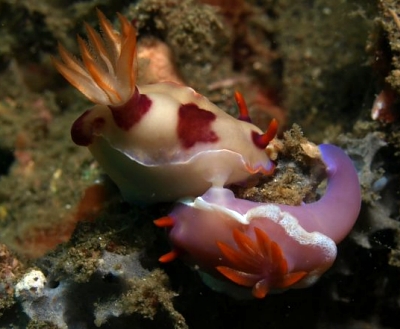
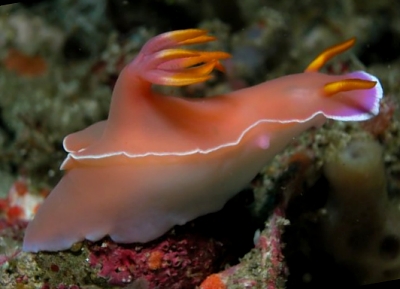
Dear Bill Rudman
As you mention in your message #6816, I also find, that the difference between Hypselodoris bullocki and Hypselodoris apolegma isn't so clear.
I send you 3 photos of special color forms of these species.
Two of the photos show H. apolegma (pink with broad white margin) and a color form that is called Hypselodoris sp.5 in Debelius/Kuiter's new Nudibranch book. As you can see they are mating, so they should be the same species.
The third photo shows a nudibranch which I think is a mixture of the two species. The front is bluish with a wider margin (like Hypselodoris apolegma), the rest of the body is typical H. bullocki.
Locality: Lembeh, 15-20m, Sulawesi, Indonesia, Pacific, 10. Juli 2007 and 29. Juli 2003, sand. Length: 5cm. Photographer: Teresa (Zubi) Zuberbühler.
Have these two species been compared (DNA)?
Teresa (Zubi) Zuberbühler
www.starfish.ch
webmaster@starfish.ch
Teresa Zuberbühler, 2008 (Apr 29) Hypselodoris bullockii? and H. apolegma mating. [Message in] Sea Slug Forum. Australian Museum, Sydney. Available from http://www.seaslugforum.net/find/20968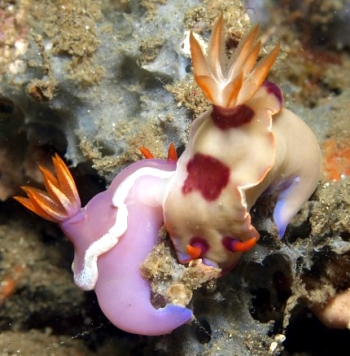
Dear Teresa,
Thanks for this interesting observation. 'Hypselodoris apolegma' seems to be a particularly incompetent species as we now have two rather spectacular mating mismatches. You have mentioned the earlier one [##6816] where I have discussed my feelings about the various colour forms of H. bullocki, and this is a second very interesting example. I thought I already had photos of this red-spotted form from Western Australia on the Forum but apparently not. Over the many years I have been studying these animals I have accumulated a number of 'puzzles' like this red-spotted one, which in external shape and internal anatomy is inseparable from specimens of the H. bullocki group. Your observation certainly confirms the close relationship between these various colour 'forms' which I hesitate to accept as species. I am not sure whethre recent DNA research has dealt with this 'H. bullockigroup'.
I wouls very much appreciate a higher resolution of the sponge the mating pair are on. I am pretty sure it is a dysideid, but I can't tell whether it is the usual Euryspongia sp. that H. bullocki and H. apolegma both feed on.
Best wishes,
Bill Rudman
Hypselodoris apolegma? from Indonesia
August 3, 2007
From: Ken Tucker
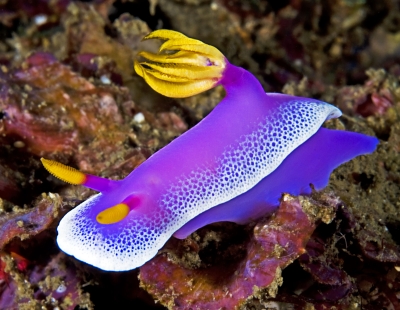
Hi Bill
The Ferrari's identify a matching image in their book "A diver's guide to Reef Life", p. 434, as Hypselodoris apolegma.
I didn't see this on the site, so I thought I would post one of my photos.
Locality: North Sulawesi, Lembeh Strait, 12 metres, Indonesia, Celebes Sea, 6 Nov 2005. Length: 2-3 cm. Photographer: Ken Tucker.
Ken Tucker
ken@kilili.com
Tucker, K.C., 2007 (Aug 3) Hypselodoris apolegma? from Indonesia. [Message in] Sea Slug Forum. Australian Museum, Sydney. Available from http://www.seaslugforum.net/find/20276Thanks Ken,
Not quite sure why you couldn't find Hypselodoris apolegma on the Forum. The name is in the Species List and certainly you get a list of references if you use the Search facility. Not that I am complaining, another record of this beautiful animal is always welcome
Best wishes,
Bill Rudman
Re: Hypselodoris apolegma feeding?
August 3, 2007
From: Ann Clear
Concerning message #20290:
Hi Bill,
Thank you for that infomation, I find it very interesting. But just for your infomation, my Husband and I were diving on our own and came across these two on this sponge. As far as I can say they were on this sponge naturally.
Best regards
Ann
ann.clear@btinterent.com
Clear, A, 2007 (Aug 3) Re: Hypselodoris apolegma feeding?. [Message in] Sea Slug Forum. Australian Museum, Sydney. Available from http://www.seaslugforum.net/find/20380Dear Ann,
Thanks for getting back to me. We will have to keep our eyes open for further sightings of this species on red sponges. I guess I should say that if you do find animals seemingly 'at home' like this it is worth just checking to see if their 'mouths' are in action. If necessary a gentle nudge to try and move the head end should give you an idea if they are feeding or not.
Best wishes,
Bill Rudman
Hypselodoris apolegma feeding?
August 2, 2007
From: Ann Clear
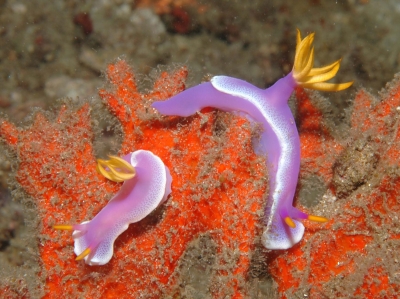
Hi Bill,
I know how interested you are in nudibranchs feeding habits, so I thought that you may like to see these two Hypselodoris bullocki having lunch.
Locality: lembeth straits, 12mtrs, indonesia, celebes sea, 10 march 2007, coral head on muck dive. Length: 2 cms. Photographer: ann clear.
Ann Clear
ann.clear@btinternet.com
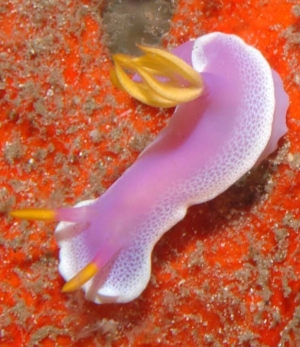
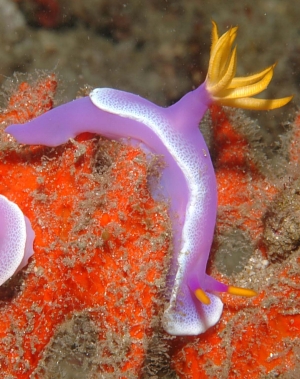
Dear Ann,
Thanks for the photo. I am surprised to see this species, which is now considered separate from H. bullocki - and known as Hypselodoris apolegma - on this red sponge. Both this species and H. bullocki have only been found feeding on a blue-purple dysideid sponge of the genus Euryspongia. That is not to say they may not eat this red sponge as well but I think we need to be cautious. I don't suppose you saw any evidence of them actually feeding on this sponge - like in Roberto Sozzani's photos in message #16276?
I assume you were diving in a group. I realise you wouldn't, but is it possible that some other members of your party could have placed these animals on the red sponge for a nice photo and left them there for you to find?
Best wishes,
Bill Rudman
Re: Hypselodoris apolegma mating
July 20, 2007
From: Asther Lau
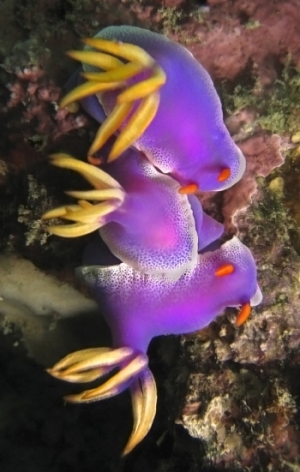
Concerning message #15038:
Dear Bill,
I came across a similar behavior with 3 Hypselodoris apolegma, however, I'm not sure if they're mating or just sleeping. I couldn't see more unless I'd to touch them & move them a little. Hence, I decided to just shoot their photos.
Locality: Mabul Island, Approximately 16 metres, Sabah, Malaysia, Celebes Sea, 26 September 2007, Submerged reef, muck diving site. Length: Between 4cm to 6cm. Photographer: Asther Lau.
Hope these photos will be useful to the forum.
Regards,
Asther
asther@astherlau.com
Lau, A, 2007 (Jul 20) Re: Hypselodoris apolegma mating. [Message in] Sea Slug Forum. Australian Museum, Sydney. Available from http://www.seaslugforum.net/find/20206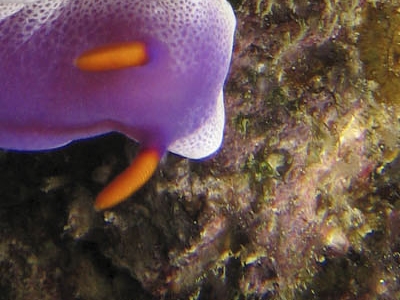
Thanks Asther,
The top two animals appear to be mating - but as they say - 'three's a crowd'.
As I have mentioned before I suspect mating animals 'meet up' because they are both attracted to the same sponge colony. I think the unlucky third animal we often see near mating pairs is there, like the mating pair, mainly because of nearby food. I can't be sure, but I think the purplish colour on the rock in the close-up photo is their food sponge Euryspongia - but not the pinkish stuff on which the mating pair are sitting - which looks like a coralline algae.
Best wishes,
Bill Rudman
Hypselodoris apolegma - feeding record [2]
March 19, 2007
From: Richard Swann
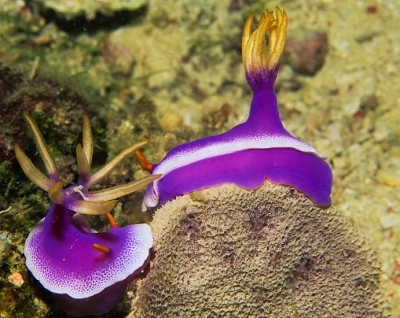
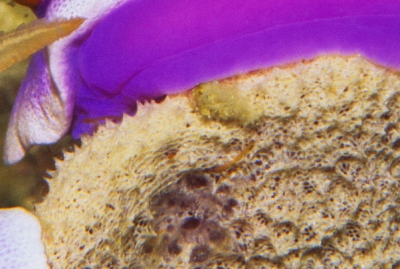
Hi again Bill
These shots were taken around half a kilometer from the one's in the previous message [#19709 ] taken a couple of months later. I feel that the sponge has almost entirely been consumed however I really don't know very much about sponges so I may be way off here. As you can see the slugs seem to be the same colour form as my previous message, again i look forward to hearing your thoughts.
Locality: Mabul island, , 24 meters. eggs at 19 meters, Sabah, Borneo, Celebes Sea, December 2006, Fringing reef slope. Photographer: Richard Swann.
I have also attached another shot of egg laying in this form but if it is of no interest please just disregard it.
Best regards
Richard
richard@downbelow.co.uk
Swann, R., 2007 (Mar 19) Hypselodoris apolegma - feeding record [2]. [Message in] Sea Slug Forum. Australian Museum, Sydney. Available from http://www.seaslugforum.net/find/19710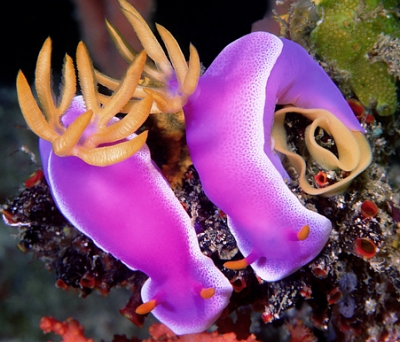
Dear Richard,
Thanks for some more valuable information. The sponge is a species of the dysideid, Euryspongia, probably the same species as in your previous message. Many sponges have different growth forms. This looks very like a spnge being eaten by H. bullocki in an earlier message of Gary Cobb's [11160]. The egg ribbon looks very like others reported for this species.
Best wishes,
Bill Rudman
Hypselodoris apolegma feeding record
March 19, 2007
From: Richard Swann
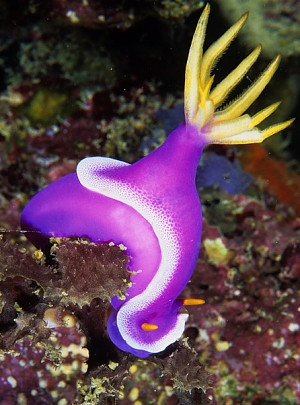
Hi Bill
I am fairly sure I have a couple of feeding records for you, I will attach the other one in a different message [#19710]. They are both the same colour form and both from the Mabul island area of Borneo. I belive that the sponge is the same species in both records .
Locality: Mabul island, , 20 meters, Sabah, Borneo, Celebes Sea, September 06, Fringing reef wall. Photographer: Richard Swann.
I hope this is of help in building up your knowledge of different forms of H bullocki.
I look forward to hearing your thoughts.
Best regards
Richard
richard@downbelow.co.uk
Swann, R., 2007 (Mar 19) Hypselodoris apolegma feeding record. [Message in] Sea Slug Forum. Australian Museum, Sydney. Available from http://www.seaslugforum.net/find/19709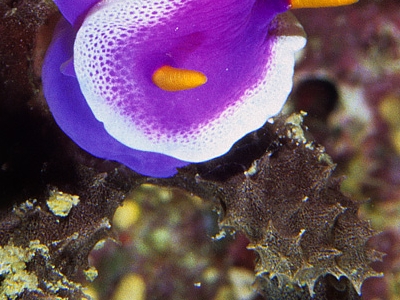
Thanks Richard,
This 'colour form' has been named Hypseldoris apolegma. You'll see from earlier messages that I am not totally convinced all the forms are good species. This sponge, a species of Euryspongia, seems to be the sole food choice of both H. apolegma and H. bullocki. It is good to get more records to support that view.
Best wishes,
Bill Rudman
Re: Hypselodoris apolegma with a parasite from Bali
December 8, 2006
From: Leslie Harris
Concerning message #18904:
Hi Bill, Mike --
This is a fairly common Cyproidea amphipod judging by the number of images of it on the web. Unfortunately I've yet to see a specific name associated with the animal. Most of the pictures show the amphipod on the blue ascidian Rhopalea. There is one shot by Roberto Sozzani in which two pods are sitting on a Phyllidia coelestis. Roberto called it a parasite but I agree with Bill's opinion - the pods are just having a joy ride. The second link has some lovely macro images taken by Jim Watt.
http://www.robertosozzani.it/Manado/contnudy4.html
http://www.kararu.com/gallery/seminars/2003/jim_watt/index.html
Cheers,
Leslie
lharris@nhm.org
Harris, L.H., 2006 (Dec 8) Re: Hypselodoris apolegma with a parasite from Bali. [Message in] Sea Slug Forum. Australian Museum, Sydney. Available from http://www.seaslugforum.net/find/18965Thanks Leslie,
My heart said amphipod but my brain said 'probably a tricky isopod'. Nice to know my heart is ok!
Best wishes,
Bill Rudman
Hypselodoris apolegma with a parasite from Bali
December 7, 2006
From: Mike Krampf
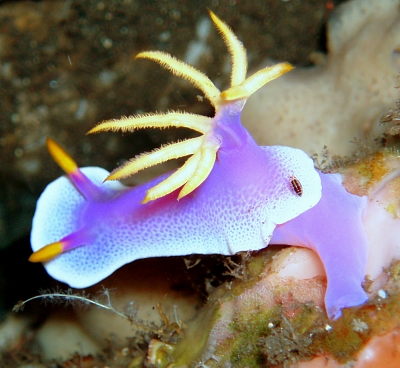
I thought you might find this picture interesting because of what appears to be some type of bug or parasite on the Hypselodoris apolegma. I found this nudi pretty deep on the wall at Drop Off.
Locality: Tulamben, 100 ft, Bali, Indonesia, Java Sea, 7 October 2006, Reef Wall. Length: 4 cm. Photographer: Mike Krampf.
Mike
mtkrampf@yahoo.com
Krampf, M., 2006 (Dec 7) Hypselodoris apolegma with a parasite from Bali. [Message in] Sea Slug Forum. Australian Museum, Sydney. Available from http://www.seaslugforum.net/find/18904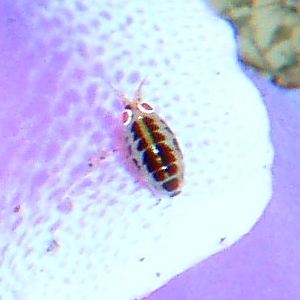
Dear Mike,
Your potential parasite is a small crustacean of some sort, either isopod or amphipod but hard to tell from this photo. I can't see a branch on the antennae so I'll plump for isopod but I am no expert on crustacea. Although some shrimps, such as Periclimenes, and many copepod crustacea are known to associate with opisthobranchs as parasites, commensals and symbionts, I can't recall any amphipods or isopods being reported to have such relationships. My guess it was just having a little adventure.
Best wishes,
Bill Rudman
Hypselodoris apolegma feeding
April 10, 2006
From: Roberto Sozzani
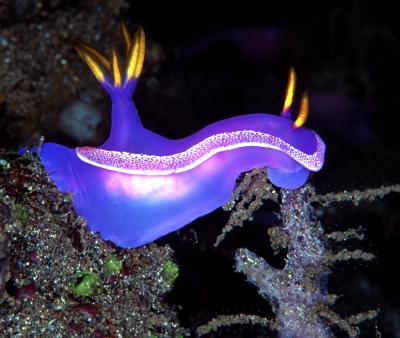
Dear Bill,
I've found this couple of Hypselodoris apolegma feeding on... I don't know what, maybe a sponge covered by hydroids? I hope this can be interesting for the Forum.
Locality: Manado - North Sulawesi, 34 metres, Indonesia, Pacific Ocean, December 2003, Sandy slope with scattered coral heads. Length: 5-6 cm. Photographer: Roberto Sozzani.
Best wishes
Roberto Sozzani
www.robertosozzani.it
roberto.sozzani@fastwebnet.it
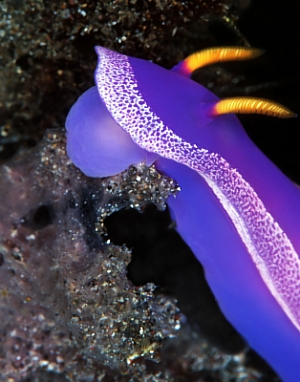
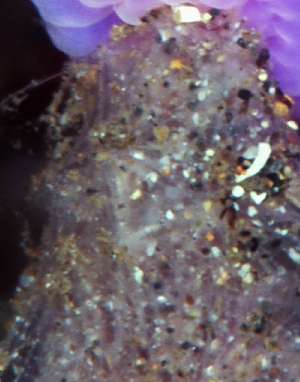
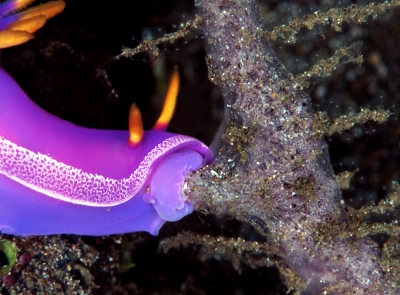
Dear Roberto,
Thanks for these photos. They have arrived at a good time, as they help illustrate the difficulties in making sponge identifications, which I have been discussing in Philippe and Guido Poppe's messages.
I think this sponge is growing up over a hydroid colony - perhaps using it as a 'backbone' or framework until it is thick enough to support itself. I would suspect the sponge is a species of Euryspongia like those eaten by H. bullocki, and illustrated in another message from the Poppes today [#16260], and also eaten by H. apolegma [see message #14140]. If you look carefully at the close-up of the sponge [middle right photo] you can see traces of the radiating pattern of fibres typical of this genus of sponges.
However I have reached that conclusion from working backwards from knowing what sponge this chromodorid probably eats. If we came at this with no knowledge of its food it would just be another tantalising example of a nudibranch clearly feeding but with no easy way of identifying the prey. To identify these non-spiculate fibrous sponges an expert needs to examine the structure of the colony and the arrangement of the fibrous skeleton - so even if a specimen of the sponge had been collected and preserved, it would be very difficult in this 'juvenile' sponge colony to examine the structure and arrangement of the fibres..
Best wishes,
Bill Rudman
Re: Hypselodoris apolegma mating
November 7, 2005
From: Arief Wiriadinata
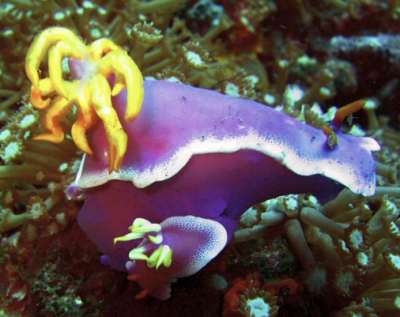
Dear Mary Jane,
I think I found one of the Hypselodoris apolegma you found mating a month-and-a-half later already with their offspring [see message #15038 ]. I'm not sure, if the reproduction process takes that long?
Locality: TK1, Lembeh Strait. North Sulawesi, Indonesia. Depth: 10 meters. 23 October 2005. Photographer: Arief Wiriadinata
Cheers,
Arief
awiriadinata@gmail.com
Wiriadinata, Arief, 2005 (Nov 7) Re: Hypselodoris apolegma mating. [Message in] Sea Slug Forum. Australian Museum, Sydney. Available from http://www.seaslugforum.net/find/15184Dear Arief,
Thanks for the photo. The length of time it takes from egg-laying to hatching varies from species to species, and we only know for a very few species. It can take between 10 days and 3 weeks or more. Some species hatch out of the egg ribbon as tiny crawling slugs, but animals with eggs as small as those of H. apolegma, hatch out of the egg as small swimming veliger larvae which swim and drift in the plankton for some weeks, where they feed on one-celled plants until they develop to a stage where they are able to settle out of the plankton back on to the sea bottom and become a crawling slug. The chance of them settling back near their parents is most unlikely, so I don't think the small one in your photo is the offspring of the large one, although a mother/father & child photo is a nice thought.
Best wishes,
Bill Rudman
Hypselodoris apolegma mating
October 20, 2005
From: Mary Jane Adams
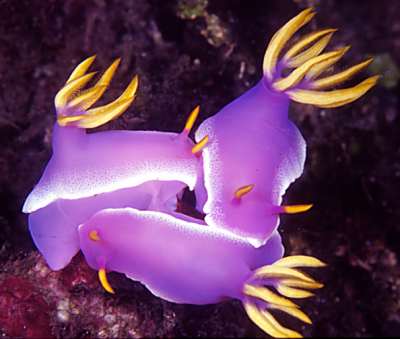
Hi Bill,
I found this trio of "Hypselodoris apolegma" on a divesite with a heavy population of variously colored Hypselodoris bullocki. I have seen this situation where two slugs are mating and a third is trying to join in so often that it makes me wonder if there is a chemical exuded during mating that is a strong attractant to other slugs that may be in the area. The two that were mating were positioned in a way that allowed me to get a close-up view of the copulatory organs.
Locality: T.K. 2, Lembeh Strait, Sulawesi Indonesia. Depth: 8 meters. Length: About 30 mm. 8 June 2005. Sand slope with patch reef. Photographer: M.J. Adams
I have been looking everywhere for "Hypselodoris apolegma " mating with another 'species', but so far I haven't seen any.
Best regards,
Mary Jane
divepng@yahoo.com
Adams, M.J., 2005 (Oct 20) Hypselodoris apolegma mating. [Message in] Sea Slug Forum. Australian Museum, Sydney. Available from http://www.seaslugforum.net/find/15038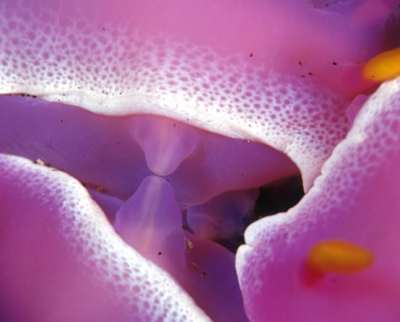
Dear Mary Jane,
I agree that finding a mate and mating are almost certainly done by chemical signals. Mind you, looking at the unsuccessful 3rd animal in your close-up photo, which is trying to mate with the top animal's rhinophore, suggests touch may be involved as well.
Concerning "Hypselodoris apolegma" mating with another 'species', I'm afraid Phil Slosberg's photo [#6816] has yet to be replicated.
Best wishes,
Bill Rudman
Hypselodoris apolegma feeding
July 4, 2005
From: Bob Whorton
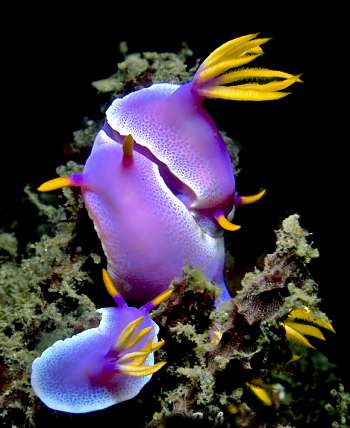
Hi Bill,
Here are a group of H. bullocki around a tasty snack by the looks of it. Couldn't see exactly what they were eating without disturbing them.
Locality: Lembeh Strait, Sulawesi, Indonesia. Black sand. Depth: 20 m.
Length: 1 - 3 cm. May 2005. Sand & flat coral outcrop. Photographer: Dr Bob Whorton
Bob
drbob.whorton@btinternet.com
Whorton, R., 2005 (Jul 4) Hypselodoris apolegma feeding. [Message in] Sea Slug Forum. Australian Museum, Sydney. Available from http://www.seaslugforum.net/find/14140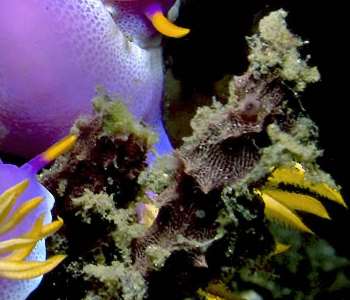
Dear Bob,
We used to consider this to be part of the Hypselodoris bullocki colour variation but it has been described as the separate species Hypselodoris apolegma. The sponge they are feeding on is a species of Dysidea. I have included a close-up from your photo showing part of th sponge colony which is recognisable. It's nice to have another record of this species on this sponge.
Best wishes,
Bill Rudman
Re: Hypselodoris bullocki - feeding and care
March 19, 2004
From: Mike Cheney
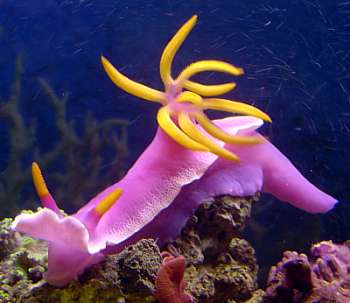
Dear Bill,
Thanks for your response [#12442]. I kinda knew what you were probably going to say. Since I wrote to you I tried the email address of the person who said they were keeping the Nudibranch alive, but it waas returned. I also Google searched for "Nudibranch growers," a few hits but all were dead ends. If there are any "Nudibranch growers" they aren't on the web. Probably because there is no such thing at this point. Too bad, if someone could develop a method of growing these creatures, like they have done for the seahorse (see: www.oceanrider.com), which was once thought impossible, they could make a fortune. Tank raised Nudibranchs would make stunning addition to marine aquariums across the world, without depleting the natural populations. Tank raised Nudibrachs would be more desirable than wild caught, like tank raised seahorse which eat manmade food. Also Nudibranchs would have a big market than seahorse have since they would be compatable with any marine aqaurium community, unlike seahorse which are very limited in the number of species that they are compatable with.
Thanks for correcting my ID of the Nudibranch, I just picked one that looked close to me. You have a huge website and so I just settled on this one as it looked very similar. As for my Hypselodoris apolegma, I gave it back to the dealer with about eight pages that I took off of your website explaining that I couldn't watch it starve to death. She said she would try to keep my Nudibranch alive for me in her Live Rock holding tank using some of the ideas she found in the post. She is going to try using the 'Angel Formula' food which has sponge in it and can be anchored on the side of a tank allowing fish and perhaps Nudibranchs to graze. However, she admitted that she had never been successful in keeping Nudibranchs before and knew that they inavariblly died in captivity after about a month or two although she didn't know it was from starvation. She believed that they were just short lived like annual flowers or something.
I'll let you know if she is successful.
Thanks for all that great work you do here.
Cordially,
Mike Cheney
High School Science Teacher
cheney777@yahoo.com
Cheney, M., 2004 (Mar 19) Re: Hypselodoris bullocki - feeding and care. [Message in] Sea Slug Forum. Australian Museum, Sydney. Available from http://www.seaslugforum.net/find/12483Thanks Mike,
I guess you have found the messages on the Keeping in captivity Page. There is one I am posting today [#12450] which describes the Angel Fish food. It will be interesting to hear if your dealer can get it to work
Best wishes
Bill Rudman
Re: Hypselodoris bullocki - feeding and care.
March 18, 2004
From: Mike Cheney
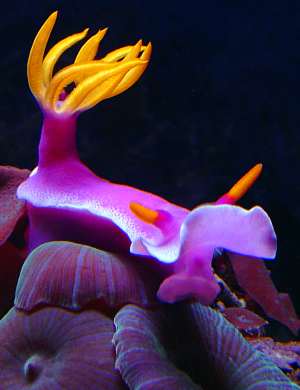
Dear Bill,
I too made the mistake of buying one of these enchanting creatures for my aquarium before reading up on there care. After reading your postings here I became very discouraged about the prospects for this beautiful creature. Then I found this one small hopeful message [#3320] about maintaining Hypselodoris in marine aquariums. This post is several years old. Has there been any follow up on this possibility?
Hopefully,
Mike Cheney
cheney777@yahoo.com
Cheney, M., 2004 (Mar 18) Re: Hypselodoris bullocki - feeding and care.. [Message in] Sea Slug Forum. Australian Museum, Sydney. Available from http://www.seaslugforum.net/find/12442Dear Mike,
I am afraid the news stays the same. The only real solution for sponge feeders, it seems to me, will be some sort of artificial food. Identifying the actual sponge species preferred by each species of nudibranch, then finding that sponge and keeping colonies alive while they are being eaten is all too difficult.
By the way, this 'species' has been named Hypselodoris apolegma
Best wishes
Bill Rudman
Re: Hypselodoris apolegma with deformed gills
October 3, 2003
From: Asther M. Lau
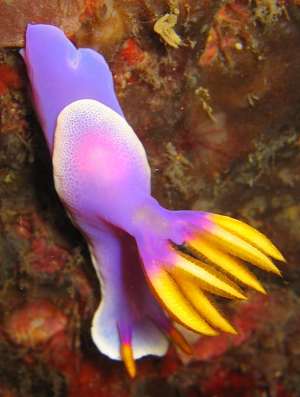
Hi again,
I think this should be another Hypselodoris apolegma.
Found both crawling towards each other in such fast motion. Took them about less than 2 mins to reach each other from a distance of 30cm.
Site: Tenggol Is, Terengganu, Malaysia
Depth: 12 meter
Date: June 1st 2003
Size: Average 6cm to 8cm when crawling
Regards,
Asther M. Lau
diveworldwide@yahoo.com
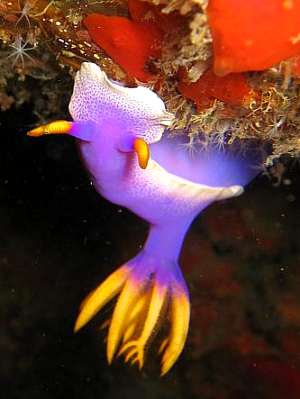
Thanks Asther,
The gill shows branching very like the one in Ray's photo. I suspect this type of branching may be different from the usual abnormalities we have been recording on the Forum. Normally abnormally shaped organs or body parts appear to be the result of a mistake during development, or the result of attempted regrowth after physical damage. I suspect in this animal, however, that the branching of the gills is a function of the size of the animal. Just as some species of Glossodoris develop secondary gill spirals in larger animals, it seems that in H. apolegma some of the gills begin branching near the tip as the animal increases in size.
Best wishes
Bill Rudman
Hypselodoris apolegma with deformed gills
August 11, 2003
From: Ray Izumi
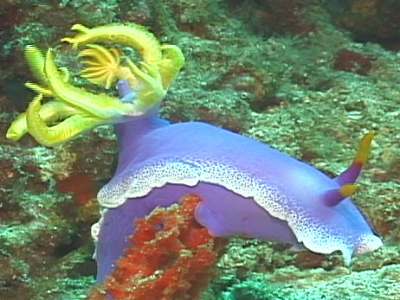
Dear Bill
Here is another addition to the "deformed nudibranch" library. It's a Hypselodoris bullocki fromm Ligpo Island, Anilao, Philippines, in May 2003. Water temp 82 degrees F, depth about 40 feet. Note the extra appendages in the gills.
Ray Izumi
izumirm@sprynet.com
Izumi, R., 2003 (Aug 11) Hypselodoris apolegma with deformed gills. [Message in] Sea Slug Forum. Australian Museum, Sydney. Available from http://www.seaslugforum.net/find/10665Thanks Ray,
This animal has recently been named Hypselodoris apolegma.
Best wishes,
Bill Rudman
Hypselodoris apolegma from Malaysia
July 5, 2003
From: Asther M. Lau
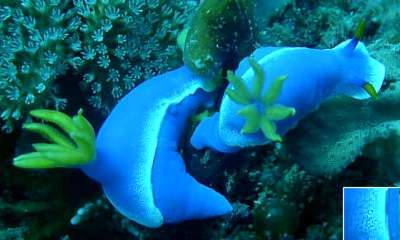
Hi again!
Here are some more pics for the collection. I think all are Hypselodoris bullocki. Please confirm. Thanx!
Upper Right: 8 meter at Gua Rajawali, Tenggol Is. Malaysia, 26th April 2003. Size: approx 2.5 - 3 cm long. Lower Left: 22 meter at Tokong Laut, Tenggol Is., Malaysia. 25th April 2003. Size: approx 1.5 cm & 3 cm long. Lower Right: 12 meter at Gua Rajawali, Tenggol Is. Malaysia. 26th April 2003. Size: approx 2.5 - 3 cm long. Photos: Adrian Yeo
Why in the lower left photo are the two slugs different sizes? Could it be possible that the smaller one is the offspring of the bigger one? They seemed to be mating.
Asther M. Lau
asther@scubadiveknit.com
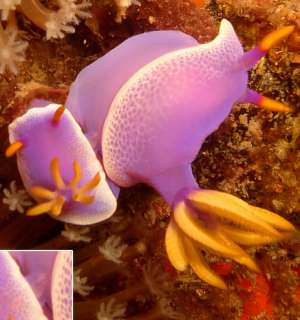
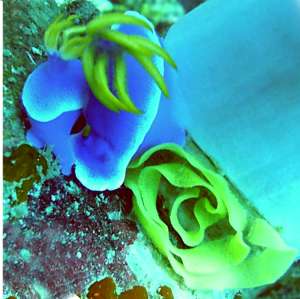
Dear Asther,
This is Hypselodoris apolegma. It's very unlikely that the small one is related to the large one. The eggs of this speies are quite small which suggests that there is a planktoni larval stage in their life history whch means it is most unlikely that a slug will settle down and grow near where its parent deposited its egg ribbon. Opisthobranchs are all all hermaphrodites which means that when they are fully mature they have fully functional male and female reproductive systems. However in many, the male organs develop first, so a subadult animal can me a functional male, if not a functional female. In your photo the small animal definitely has its penis extended, suggesting that its male system is developed. However it won't have much joy in this position because the female genital opening of its large 'partner' is on the other side of its body.
Best wishes,
Bill Rudman
Hypselodoris apolegma from Malaysia
February 12, 2003
From: Kelvin Tan
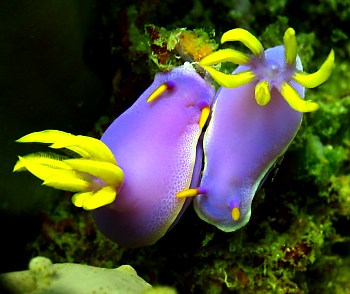
I could not find the scientific name for this sea slug and I would greatly appreciate your expertise in identifying them.
Image Data: found July 2003, Tenggol, Malaysia.
Greatly appreciated.
Kelvin Tan
lanxx@pacific.net.sg
Tan, K., 2003 (Feb 12) Hypselodoris apolegma from Malaysia. [Message in] Sea Slug Forum. Australian Museum, Sydney. Available from http://www.seaslugforum.net/find/9124Dear Kelvin,
This species, previously considered a colour form of Hypselodoris bullocki has recently been named H. apolegma, although as you'll see from my comments on the Fact Sheet, I still have doubts about whether it is a good species. Your animals appear to be much yellower than usual. From the strong yellow cast in the background I wonder if for some reason the colour is a little bit wrong in this photo?
Best wishes,
Bill Rudman
Hypselodoris apolegma
October 31, 2002
From: Bill Rudman
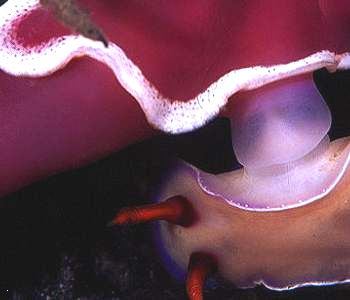
I have decided to move the messages concerning Hypselodoris apolegma to a separate page, rather than leaving them with H. bullocki. I still have not resolved the question raised by Phil Slosberg's photo of the two 'species' mating [see alongside], but separating the two to different pages makes management of the incoming messages easier for me.
Cheers,
Bill Rudman
Hypselodoris apolegma from west Malaysia
October 31, 2002
From: Kheong Sann Chan
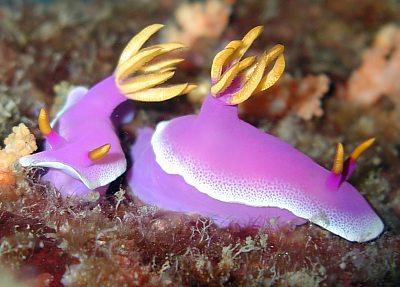
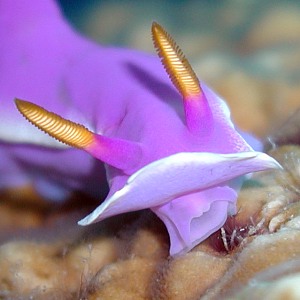
Dear Bill,
In June I had another great dive trip to Pulau Dayang off the east coast of west Malaysia. It seems to me that the nudibranchs are getting more and more plentiful at Dayang. Normally I would see nudis occasionally here and there. On this trip, I would come across a rock which had maybe 5 or 6 conspicuously visible nudis on it, maybe more hidden around. Here is the first of several messages about our purple friend which I mistook for H. bullocki before. One of them was flapping it's mantle up and down as it moved like Chromodoris kuniei does, but only in the front instead of all around. I managed to get a peep under it's hood.
Location: Dayang, Pinnacles
Date: 8 June, 0800
Depth: 20m
Kheong Sann Chan
kschan@mail.dsi.nus.edu.sg
Chan, K.S., 2002 (Oct 31) Hypselodoris apolegma from west Malaysia. [Message in] Sea Slug Forum. Australian Museum, Sydney. Available from http://www.seaslugforum.net/find/7207Thanks Kheong,
It certainly wasn't a mistake to identify this animal as H. bullocki. As I have discussed a number of times, and again today, I still have my doubts about whether it is a good species or not. If you ever see 'typical' H. bullocki and H. apolegma together again, as in an earlier message of yours, it may be worth seeing if you can get the two 'species' to take a romantic interest in each other
Best wishes,
Bill Rudman
Hypselodoris apolegma feeding
October 31, 2002
From: Kheong Sann Chan
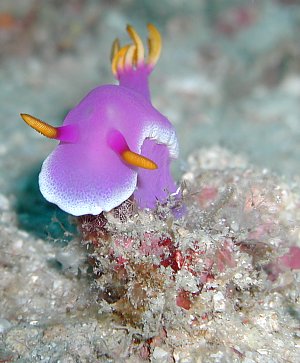
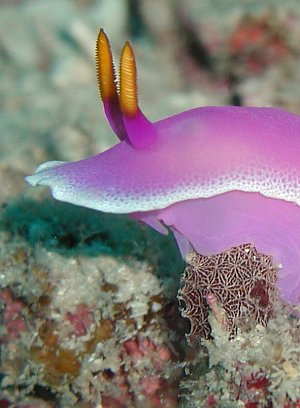
Here are some more photos of Hypselodoris apolegma from Pulau Dayang off the east coast of west Malaysia. They appear to be feeding.
Location: Dayang, Pinnacles
Date: 8 June, 0800
Depth: 20+m
Kheong Sann Chan
kschan@mail.dsi.nus.edu.sg
Chan, K.S., 2002 (Oct 31) Hypselodoris apolegma feeding. [Message in] Sea Slug Forum. Australian Museum, Sydney. Available from http://www.seaslugforum.net/find/7208Dear Kheong,
They certainly seem to be taking an interest in this purple sponge, but unfortunately it just seems to be sitting on it in this photo. Unless we can see the oral tube everted on to the sponge, as in Nishina Masayoshi's and Jun Imamoto's photos of H. festiva, we really can't give this more than a 'not proven'.
Best wishes,
Bill Rudman
Hypselodoris apolegma mating
October 31, 2002
From: Kheong Sann Chan
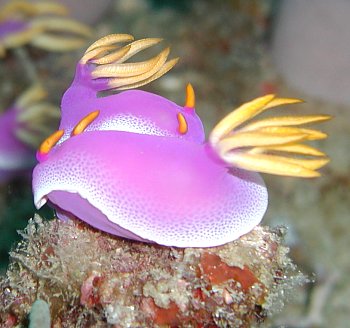
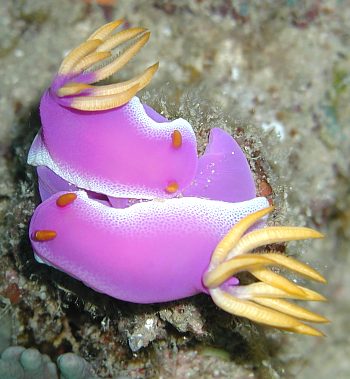
Dear Bill,
Here are some more photos from Pulau Dayang, off the east coast of west Malaysia, of Hypselodoris apolegma mating.
Location: Dayang, Pinnacles
Date: 8 June, 0800
Depth: 20m
Kheong Sann Chan
kschan@mail.dsi.nus.edu.sg
Chan, K.S., 2002 (Oct 31) Hypselodoris apolegma mating. [Message in] Sea Slug Forum. Australian Museum, Sydney. Available from http://www.seaslugforum.net/find/7209Thanks Kheong,
Before the advent of digital cameras this is the sort of animal that must have had photosuppliers drooling. It is definitely the animal you just want to keep on taking photos of.
Best wishes,
Bill Rudman
Hypselodoris bullocki-apolegma from Malaysia
July 21, 2002
From: Richard Houghton
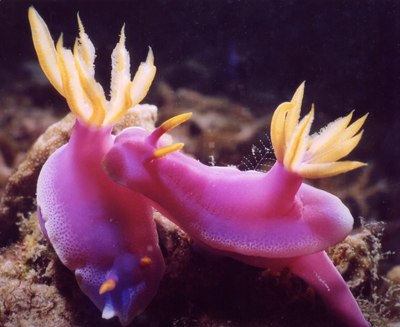
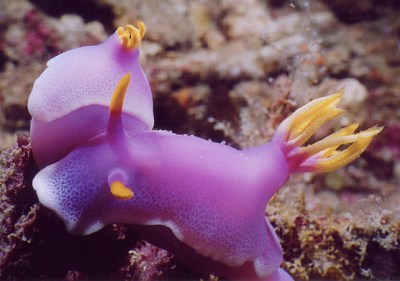
Hi Bill.
These are from Pulau Aur, Malaysia. Found in 7 metres of water. 60mm in length. June 2002.
On two separate trips (two weeks apart) we found this species engaged in procreation. They were not the same individuals in both places as they were probably 100 metres apart at least.
Rich
richard_houghton@hotmail.com
Houghton, R., 2002 (Jul 21) Hypselodoris bullocki-apolegma from Malaysia. [Message in] Sea Slug Forum. Australian Museum, Sydney. Available from http://www.seaslugforum.net/find/7509Dear Rich,
This is an animal I have been calling a 'colour form' of Hypselodoris bullocki but Nathalie Yonow recently described it as a new species Risbecia apolegma. However I have also posted a photo which shows 'Risbecia apolegma' mating with a more typical H. bullocki which suggests we still have things to learn about this colour group. I must say I have been overwhelmed by the silence after posting the mating photo. I thought I might have got some comments. Does anyone else think it is significant or are we generally happy with the idea of interspecies mating?
Cheers,
Bill Rudman
'Risbecia apolegma' from Malyasia
June 5, 2002
From: Kheong Sann Chan

Dear Bill,
.. and here are 3 more photos of another H. bullocki nearby to where I photographed the others, but I can't figure out what he is doing. are those eggs that he is on, or is he eating some sponge?
Tenggol Island off the coast of east Malaysia on 24 May 2002. Depth was 13m.
Kheong.
kschan@mail.dsi.nus.edu.sg
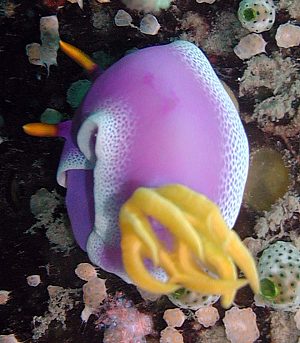
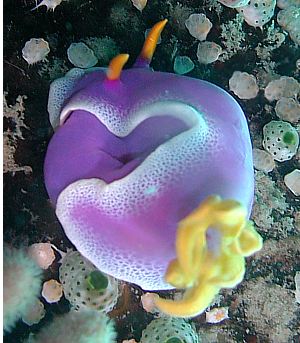
Thanks Kheong,
This 'species' or 'colour form' has recently been named Risbecia apolegma. I have recently posted a photo of this 'colour form' mating with a typical H. bullocki so I am at a loss to know just what to think. I am surprised to have had no comment about this photo as to me it suggests they are the same species.
Thanks for this great series of photos of H. bullocki and its 'relatives'.
Cheers,
Bill Rudman
Hypselodoris cf. bullocki = Risbecia apolegma
May 1, 2002
From: Clay Carlson
Bill,
Chan's animal has recently been named by Yonow as: Risbecia apolegma.
• Yonow, N. 2001 Part 11. Doridacea of the families Chromodorididae and
Hexabranchidae (Mollusca, Gastropoda, Opisthobranchia, Nudibranchia), including additional Moluccan material. in Results of the Rumphius Biohistorical Expedition to Ambon (1990). Zoologische Meddelingen. Leiden, 75: 1-50.
Clay Carlson
clay.carlson@kuentos.guam.net
Carlson, C., 2002 (May 1) Hypselodoris cf. bullocki = Risbecia apolegma. [Message in] Sea Slug Forum. Australian Museum, Sydney. Available from http://www.seaslugforum.net/find/6827Thanks Clay,
I had recently heard that it had been named but no-one had told me its name or given me a reference. Our copy of the journal has not yet arrived so I wait with interest. Even more interesting is the photo I have just posted of Hypselodoris bullocki and Risbecia apolegma mating.
Best wishes,
Bill Rudman
Hypselodoris cf. bullocki from Malaysia
April 27, 2002
From: Kheong Sann Chan
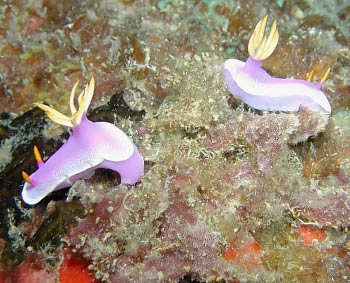
Hi Dr. Rudman,
Here are some photos from Pulau Dayang off the East Coast of Malaysia. Depth varied approximately 15-23m deep. 14 April 2002
Kheong.
kschan@mail.dsi.nus.edu.sg
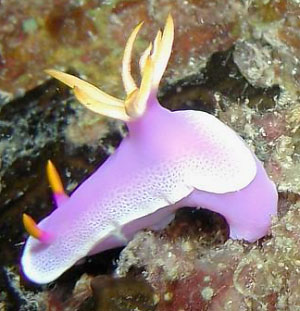
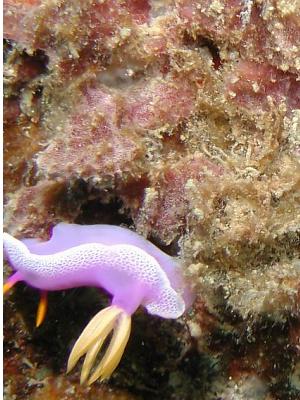
Dear Kheong,
This is the nudibranch which appears in your earlier photo with mating Hypselodoris bullocki. Its an interesting set of photos because it shows them apparently feeding on a large pinkish coloured sponge colony, which looks very similar to a sponge that H. bullocki also feeds on.
Best wishes,
Bill Rudman
Hypselodoris bullocki colour group (1)
April 9, 2002
From: Bernard Picton
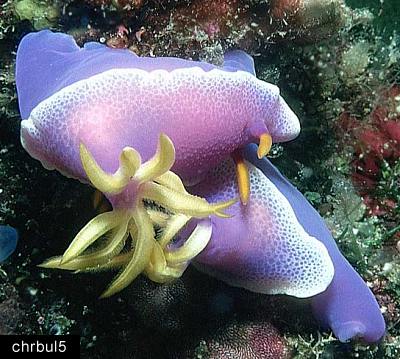
Hi Bill,
Looking at Hypselodoris bullocki on the Forum I don't see any pictures of the large form of this "species" (colour group?) which I have seen many times in Indonesia. These animals are typically 6cm long, the gills and rhinophores are orange, and spots of background purple/pink colour break through the white marginal band which gradually fades away towards the centre of the mantle. I've seen these animals mating and the large ones I have seen have all been this colour form in Bali, Hoga, and Sipadan Is.
Pictures of this form:
chrbul2 - Kubu, East coast Bali, Mar 1989
chrbul3 - Hoga, SE Sulawesi, October 1997
chrbul4 - NW Bali, March 1996
chrbul5 - Hoga, SE Sulawesi, October 1997
Compare these with the photo of a small form I have sent in a separate message. I'm sure these are different species, perhaps we should take a "precautionary principle" approach with these and consider different colour forms to be a mimicry/colour group until proven otherwise. If you had not started this approach with the "quadricolor" colour group we would never have got to
where we are now; ie. a better understanding of the species involved ;-) !
Looking at the pictures in Debelius there may be as many as six species shown there in my opinion, there is a picture of the small form I describe here (also mating) on the front cover.
Bernard
bernard.picton.um@nics.gov.uk
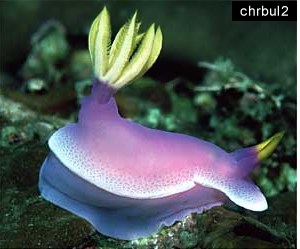
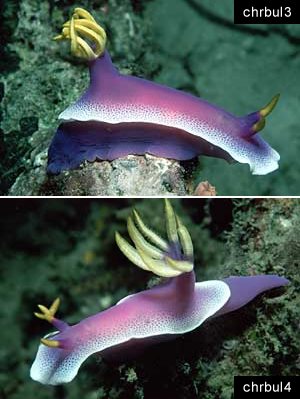
Thanks Bernard,
I am sure you are probably right. I have just continued to 'lump' them together as the "H. bullocki group' in the hope that someone would study them as a group and not see them picked off one by one by people more interested in naming a new species than in understanding what is going on in the group. The problem with the 'one at a time approach' is that someone else is still left to do the real work of sorting out the complex, looking at limits of colour variation etc.
Best wishes,
Bill Rudman
PS: [I'm sorry to say this is one of the messages that got stuck in the backlog. You will see that since you sent it I have posted a photo of this form from Indonesia from Tony Wu.]
Rudman, W.B., 2002 (Apr 9). Comment on Hypselodoris bullocki colour group (1) by Bernard Picton . [Message in] Sea Slug Forum. Australian Museum, Sydney. Available from http://www.seaslugforum.net/find/6429Hypselodoris bullocki? from Indonesia
April 7, 2001
From: Tony Wu
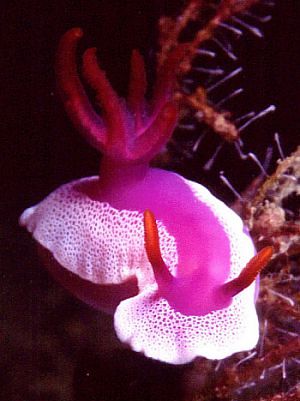
Hi Bill,
I think this is Hypselodoris bullocki, but I am not sure, given all the colour pattern variations. What do you think?
This was taken in East Kalimantan, Indonesia, at a depth of about 8-9 metres.
Tony Wu
osiris@singnet.com.sg
Wu, T., 2001 (Apr 7) Hypselodoris bullocki? from Indonesia. [Message in] Sea Slug Forum. Australian Museum, Sydney. Available from http://www.seaslugforum.net/find/4112Dear Tony,
At present I am 'storing' all these animals under Hypselodoris bullocki until we can find some good evidence to separate them into different species.
Best wishes,
Bill Rudman
